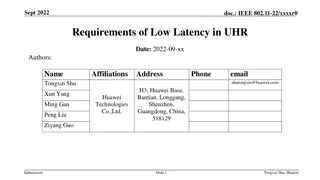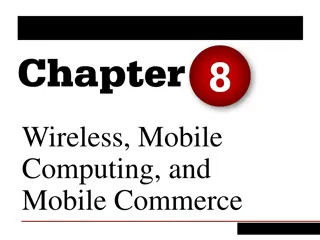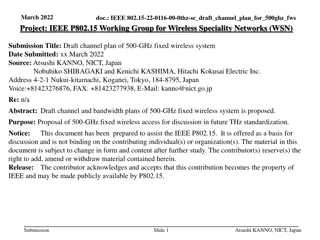Way Forward on Ultra-Low BLER Requirements in Wireless Communication
Explore the agreements and discussions around ultra-low BLER (Block Error Rate) requirements for URLLC (Ultra-Reliable Low Latency Communication) in wireless communication systems. Gain insights into the test methodologies, decision co-ordinates, applicability rules, and open issues related to CQI (Channel Quality Indicator) and BLER testing, aiming at ensuring reliable and low-latency connectivity. Delve into the challenges and considerations in setting ultra-low BLER standards for different features within the wireless infrastructure.
Download Presentation

Please find below an Image/Link to download the presentation.
The content on the website is provided AS IS for your information and personal use only. It may not be sold, licensed, or shared on other websites without obtaining consent from the author.If you encounter any issues during the download, it is possible that the publisher has removed the file from their server.
You are allowed to download the files provided on this website for personal or commercial use, subject to the condition that they are used lawfully. All files are the property of their respective owners.
The content on the website is provided AS IS for your information and personal use only. It may not be sold, licensed, or shared on other websites without obtaining consent from the author.
E N D
Presentation Transcript
Way Forward on ultra-low BLER requirements R4-2012646 Moderator (Ericsson)
Agreements in second round FR2: Not introduce FR2 requirements in Rel-16 for URLLC with ultra-BLER. CQI: From GTW: Work assumption: Introduce ultra-BLER static CQI test cases under the assumption that test time is similar as Fixed MCS test cases ; further discuss how to ensure reasonable test time with below possible options: -Decrease confidence level (from 99.999% ~95%) -Early pass/fail criteria Note both options adopted not excluded.
Agreements in second round Test applicability for the BS: If both 15kHz and 30kHz SCS are supported, the manufacturer can declare/decide which one is tested. BS test methodology: Captured in Annex Applicable for 10^-5 BLER and 99.999% CL only Asymmetric per step risks should be used, as in RAN5 LTE (TS 36.521-1, G.7.10) and RAN5 NR (TS 38.521-4 G.2.10). Include a table of decision co-ordinates
Agreements in second round No ultra-low BLER requirements for the following features within this WI (high BLER requirements for these features to be discussed separately in thread 319): PDCCH enhancements Multi-TRP for URLLC PUSCH repetition type B UCI enhancements No requirement for 10^-6 BLER in rel-16
Open issues CQI: How to define the requirement: Option 1: Median CQI, BLER for median CQI+1/medianCQI-1 Option 2: Median CQI, BLER for median CQI and median CQI+1 or median CQI - 1 Applicability rule for fixed MCS and CQI testing To be discussed further once CQI requirement/test is resolved Detailed description of the test methodology in the BS conformance specification RAN5 description should be a starting point Companies are encouraged to provide proposed text for the next meeting; please co- ordinate with the editors for the 38.141-1 and 38.141-2 CRs for ultra-low BLER Companies are encouraged to contribute on the per step risk and the decision co- ordinates table in particular for the next meeting
Open issues Note on X in BS spec: Option 1: 1dB is added to the test requirement to facilitate early test pass. The BLER delivered by the device during the test will be lower than the test requirement, which enables compliance to the requirement to be demonstrated with a number of observed block errors lower than a certain threshold. Option 2: 1dB is added to the test requirement to allow test termination within a feasible time frame
Agreed simulation assumptions (UE) Parameter Value Frequency range FR1 Transform precoding Disabled Duplex mode FDD/TDD 1x2, ULA low 1x4, ULA low Antenna configuration Mapping type Type A Starting symbol (S) 2 PDSCH configuration Length (L) 12 PUSCH aggregation factor 1 DMRS Type Type 1 Single-symbol DM-RS PDSCH DMRS configuration DM-RS duration Number of additional DMRS 1 Number of HARQ Transmissions 1 PT-RS Disabled Propagation condition AWGN MCS Table Table 3, MCS14 FDD:15KHz, 10MHz TDD:30KHz, 40MHz SCS and BW Frequency domain resource Full BW TDD pattern 7D1S2U (S=6:4:4) Target BLER: 10-5 Testing metric
Agreed simulation assumptions (BS) Parameter Value Frequency range FR1 Transform precoding Disabled Antenna configuration 1x2, ULA low Mapping type Type A and Type B Starting symbol (S) 0 PUSCH configuration Length (L) 14 PUSCH aggregation factor 1 DMRS Type Type 1 Single-symbol DM-RS PUSCH DMRS configuration DM-RS duration Number of additional DMRS 1 Number of HARQ Transmissions 1 PT-RS Disabled Propagation condition AWGN MCS Table Table 3, MCS 5 15 kHz for 10 MHz (see NOTE) 30 kHz for 40 MHz (See NOTE) SCS and BW Frequency domain resource Full Bandwidth 15 kHz SCS: 3D1S1U, S=10:2:2 30 kHz SCS: 7D1S2U, S=6:4:4 TDD pattern Target BLER: 10-5 Testing metric NOTE: It was previously agreed to follow the decision for slot aggregation regarding supported bandwidths. Thus if decided for slot aggregation, then 5MHz should be added for 15k SCS and 10MHz for 30k SCS. Other parameters will remain the same in these cases.























